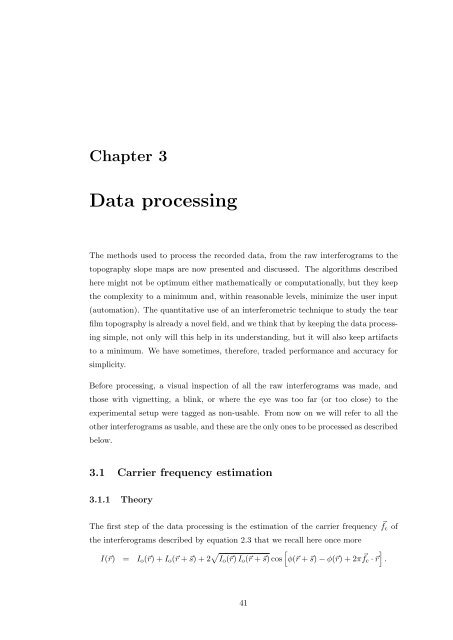Alfredo Dubra's PhD thesis - Imperial College London
Alfredo Dubra's PhD thesis - Imperial College London
Alfredo Dubra's PhD thesis - Imperial College London
You also want an ePaper? Increase the reach of your titles
YUMPU automatically turns print PDFs into web optimized ePapers that Google loves.
Chapter 3<br />
Data processing<br />
The methods used to process the recorded data, from the raw interferograms to the<br />
topography slope maps are now presented and discussed. The algorithms described<br />
here might not be optimum either mathematically or computationally, but they keep<br />
the complexity to a minimum and, within reasonable levels, minimize the user input<br />
(automation). The quantitative use of an interferometric technique to study the tear<br />
film topography is already a novel field, and we think that by keeping the data processing<br />
simple, not only will this help in its understanding, but it will also keep artifacts<br />
to a minimum. We have sometimes, therefore, traded performance and accuracy for<br />
simplicity.<br />
Before processing, a visual inspection of all the raw interferograms was made, and<br />
those with vignetting, a blink, or where the eye was too far (or too close) to the<br />
experimental setup were tagged as non-usable. From now on we will refer to all the<br />
other interferograms as usable, and these are the only ones to be processed as described<br />
below.<br />
3.1 Carrier frequency estimation<br />
3.1.1 Theory<br />
The first step of the data processing is the estimation of the carrier frequency ⃗ f c of<br />
the interferograms described by equation 2.3 that we recall here once more<br />
I(⃗r) = I o (⃗r) + I o (⃗r + ⃗s) + 2 √ [<br />
I o (⃗r) I o (⃗r + ⃗s) cos φ(⃗r + ⃗s) − φ(⃗r) + 2πf ⃗ ]<br />
c · ⃗r .<br />
41

















